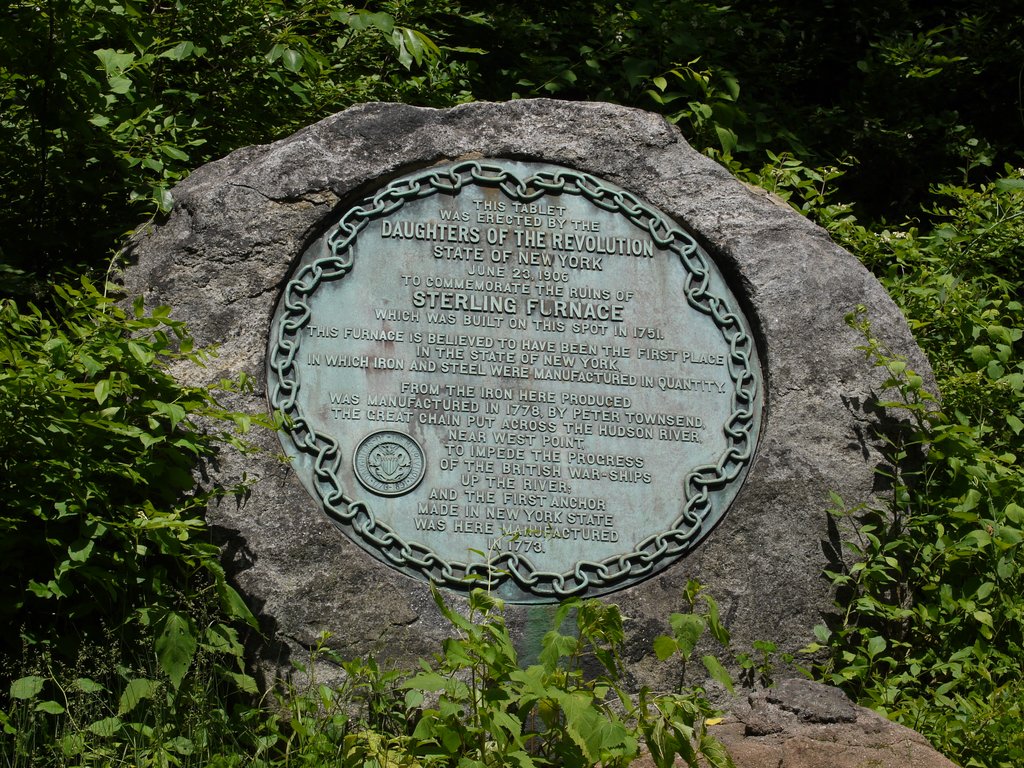THE GREAT CHAIN ACROSS THE HUDSON: INTRO
The Great Chain Celebrated its 240th anniversary in 2018
In 1778 after previous failed attempts to block British access to the upper Hudson River, the Great Chain was forged at Sterling in what today is the Town of Warwick. The chain was successful in keeping the enemy from continuing up the river to cut off New England, which would have been disastrous for the cause of the rebelling colonies. Read: The 240th Anniversary of the Chain: A great achievement and its rediscovery
Video of the Thirteen Links at West Point
These links at Trophy Point at West Point are some of the few surviving links of the Great Chain.
Chronology
- 1776 -- An obstruction of logs (chevaux-de-frise) is placed between Fts. Washington and Lee. The British soon discover the strategic gap. Henry Wisner of Goshen Precinct (born near Mt. Eve) and Gilbert Livingston sound the Hudson to determine places where an obstruction could successfully be placed.
- 1776-1777 -- A partially successful chain and boom are run across the river just north of Ft. Montgomery; it too fails to stop the British ships and they sail up the river and burn Kingston, where the new government has been headquartered. A second chevaux de frise was partially completed between Plum Point and Pollepel's Island.
- 1778 January -- A committee of four which included Warwick's Col. John Hathorn determined that the best place for an obstructing chain would be at West Point
- 1778 January - April -- The contract for the forge specifies that the chain will be made of Sterling Iron, which was stronger iron than other area mines. The iron is mined and forged at Sterling Forge in Warwick. The huge links are carried a few at a time to a forge nearer the Hudson to be assembled.
- 1778 April - The Great Chain is stretched across the Hudson which successfully prevents the British from further navigating up the Hudson to cut the rebelling colonies in two.
Washington's Watch Chain -- Painting by Mort Kunstler
Washington's Watch Chain Copyright Mort Kunstler. Used with permission of the artist. See website for more info. (click painting).
"Washington's Watch Chain" by storyteller Jonathan Kruk
Warwick Men Who Helped Make or Guard the Chain
The following local men are among those who helped create the Great Chain or guarded it, as stated in pension applications for Revolutionary Service or other documentation; research continues.
- Bennett, Elisha (Ensign, Sterling Company, Hathorn’s Reg’t)
- Conkling, Joseph (Ensign, Sterling Company, Hathorn’s Reg’t)
- Finch, Solomon (Lieut., Sterling Company, Hathorn’s Reg’t)
- Finton, John (blacksmith)
- Fitzgerald, John (Lieut., Sterling Company, Hathorn’s Reg’t)
- Miller, Alexander
- Norman, John (Capt., Sterling Company, Hathorn’s Reg’t)
- Sly, Conrad (Hathorn’s Reg’t; blacksmith; his home now the Landmark Inn)
- Townsend, Henry (Capt., Sterling Company, Hathorn’s Reg’t)
All men of the Sterling Company were “forgemen”, according to a letter Hathorn wrote in July of 1779.
The Sterling Forge and Furnace
READ:
The Sterling furnace and the West Point chain; an historical address delivered at Sterling Lake by Coxe, Macgrane, 1859
The Contract for the Great Chain by Jephtha Simms, 1883
Mystery Solved! The Forge Location Discovery
The exact location of the forge where the chain was shaped was lost to time until it was recently announced that Donald "Doc" Bayne, President of the Friends of Sterling Forest, painstakingly followed the clues to rediscover this nationally significant site. Attend one of his lectures or hikes at Sterling Forest State Park to learn more.


